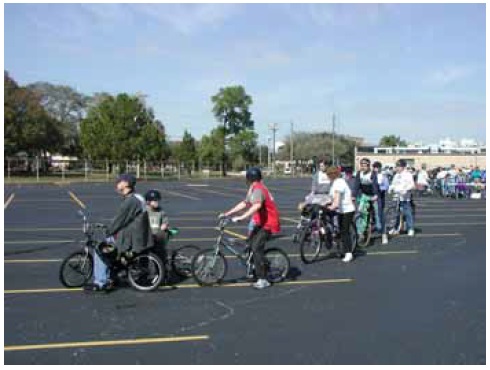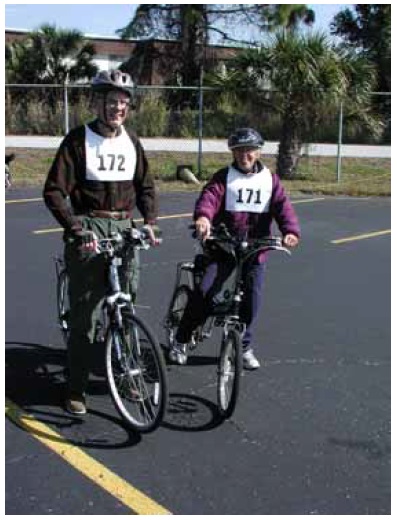Design of Shared Use Paths, Street Intersections, and Midblock Crossings
This federally sponsored research reveals that in many cases, neither the bicycle nor the pedestrian is the design "vehicle" or user for shared use paths, their intersections with roadways, or for a host of other features throughout the transportation system of the United States. This is an important discovery, confirming what some professionals have suspected: that a number of our design guidelines need to be changed or expanded, and/or new ones added. This is an urgently needed action. Hundreds, if not thousands, of transportation facilities and signals are being designed and built today that do not, or will not, in the very near future, safely accommodate a growing number of nonmotorized users. While the above outlined presentations may help bring about a general awareness within the professional community of bicycle and pedestrian mode planners, they represent a small portion of the design professionals preparing designs and construction documents of signalized roadway and street intersections, midblock pedestrian signals, shared use paths, roads and streets, etc. These tens of thousands of design professionals need to be aware of the possible implications of this study on transportation system designs.

Figure 53. Many users of various ages and abilities participated in each "Ride for Science."
Furthermore, they need training on the proper design to safely accommodate the growing array of users of transportation facilities (figures 53 and 54), and the operational characteristics of persons using the expanding array of assistive devices.

Figure 54. two "Ride for Science" participants.
Accordingly, either revisions are needed to NHI's bicycle and pedestrian facility design courses, the existing AASHTO design guidelines (A Policy on Geometric Design of Highways and Streets, Guide to the Development of Bicycle Facilities and the upcoming Pedestrian Facilities Design Guide) and FHWA's Manual on Uniform Traffic Control Devices (MUTCD), and/or the creation of a totally new NHI course and a new AASHTO design guideline (for shared use paths) should be created. The information could also be put into the revised Ped/Bike University Course. Regardless of the approach taken, certain recommended minimum elements are needed for courses/design guidelines to ensure the safe design and operation of transportation facilities serving nonmotorized users. The major sections that need to be included or referenced are:
1. Design Controls and Criteria.
2. Elements of Design.
3. Cross-sectional Elements.
4. At-grade Intersection Design.
5. Design of Grade-separated Crossings.
6. Sidewalks and "Sidepath" Design Guidance.
These sections are further detailed below.
1. Section 1 - Design Controls and Criteria
A. Function and Purpose of Shared Use Paths, Street Intersections, and Midblock Crossings
1. History of the Facility Types
2. Expectations of the Users
B. Design Users and Operational Characteristics
1. Population of Current and Emerging Users
2. Bicyclists
3. Pedestrians
4. Inline Skaters
5. Recumbents
6. Hand Cycles
7. Wheelchair Users
8. Canes, Walkers, and Related Ambulatory Devices
9. The Segway
10. Etc.
C. Facility Operation and Level of Service Concepts
1. Homogenous User Operation
2. Bicycle and Pedestrian Users
3. Mixed Flow
4. Street Intersections
5. Midblock Crossings
D. ADA Geometric Criteria
E. Speed
1. Operating Speed
2. Running Speed
3. Design Speed
2. Section 2 - Elements of Design
A. Sight Distance
1. Stopping Sight Distance
a. Reaction Time
b. Braking Distance
c. Design Values
2. Criteria for Measuring Sight Distance
a. User Eye Heights
b. Object Height
B. Horizontal Alignment
1. General Considerations
a. Superelevation
b. Friction Factors
2. Design Considerations
3. Sight Distance on Horizontal Curves
a. Stopping Sight Distance
b. Passing Sight Distance
C. Vertical Alignment
1. Grades
2. Vertical Curves
a. General Considerations
1. Population of Users
2. Critical Design User
3. Crest Vertical Curves
4. Sag Vertical Curves
5. Sight Distance at Undercrossings (Grade Separated Intersections)
3. Section 3 - Cross Section Elements
A. Pavement
B. Width
C. Shoulders and Sideslopes
1. Width and Slope of Shoulders
2. Horizontal Clearance to Obstructions
3. Sideslopes
D. (Traffic) Barriers and Railings
E. Cross Sections through Grade Separated Intersections
4. Section 4 - At-Grade Intersections
A. General Design Considerations and Objectives
B. Operational Capabilities of Users
1. Acceleration
2. Gap Acceptance
3. Future Trends in Capabilities
C. Types and Examples of Intersections
1. Signalized Street Intersections
2. Midblock Crossings
D. Assignment of Priority
1. Yield
2. Stop
3. Signalized Control
E. Intersection Sight Distance
1. Path / Path intersections
a. Sight Triangles
1. Approach Sight Triangles
2. Departure Sight Triangles
b. Intersection Control
2. Roadway / Path (Midblock) Intersections
a. Sight Triangles
1. Approach Sight Triangles
2. Departure Sight Triangles
b. Median Refuges
c. Alternative Routing of Shared Use Path
F. Ramps and Vertical Design Considerations
G. Treatments through Interchange Areas
H. Crossing Safety Intervention Measures
5. Section 5 - Grade Separated Intersections
A. Warrant Guidelines for Grade Separation
B. Overpass versus Underpass Structures
C. Lateral and Vertical Clearances
D. Approaches (e.g., Ramps and Elevators)
6. Section 6 - Sidewalks and Sidepaths
A. Introduction and History
B. Crash Statistics
C. The Conflicts and Confusion
D. The Limited Applications and Design Guidelines

User Comments/Questions
Add Comment/Question